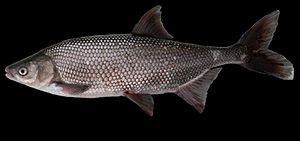Hitch (fish) facts for kids
The hitch (Lavinia exilicauda) is a type of fish that belongs to the minnow family, called cyprinids. It lives only in central California. This fish used to be very common. Its name, "hitch," might come from an old Pomoan word for this kind of fish. The hitch is the only species in its group, called Lavinia.
Quick facts for kids Hitch (fish) |
|
|---|---|
 |
|
| Conservation status | |
| Scientific classification | |
| Synonyms | |
|
Contents
How Scientists Classify the Hitch
Scientists first officially described the hitch in 1854. This was done by Spencer Fullerton Baird and Charles Frédéric Girard. They found it in the Sacramento River in California.
The hitch is closely related to another fish, the California roach (Hesperoleucus symmetricus). These two fish can even have babies together. However, studies of their DNA show that they are still different types of fish. The hitch belongs to a larger group of fish called Cyprinidae, which includes many kinds of minnows.
Different Types of Hitch
There are three main groups, or subspecies, of the hitch fish:
- Clear Lake hitch: This type is found in Clear Lake.
- Monterey hitch: Also known as the Salinas hitch or Pajaro hitch.
- Sacramento hitch: Also called the Central Valley hitch.
What the Hitch Looks Like
The hitch fish has a deep, flat body. It has a small head and a mouth that points upwards. They are mostly silver all over. Younger hitch fish have a black spot near their tail. This spot fades as they get older, and their color becomes darker.
Their anal fin (the fin on their belly near the tail) is longer than other California minnows. It has 11 to 14 rays. The dorsal fin (on their back) has 10 to 13 rays. It is placed further back on their body. Their tail fin is large and deeply split. Hitch fish can grow quite large for minnows, up to 36 centimetres (14 in) long. They look a lot like the golden shiner fish.
What the Hitch Eats and Where It Lives
Hitch fish are omnivores, meaning they eat both plants and animals. They live in open water and eat things like algae, insects, and tiny water creatures called zooplankton. You can find them in lakes, slow-moving parts of rivers, and streams.
They can live in both warm and cool water. This is because they can handle a wide range of temperatures. They can also live in water that is a bit salty. For example, they are found in the Suisun Marsh and the Salinas River lagoon, where the water has some salt.
Where the Hitch Is Found
The hitch lives in several rivers and lakes in California. These include the Sacramento River and San Joaquin River systems in the Central Valley. They are also found in the Russian River, Clear Lake, Pajaro River, and Salinas River.
Even though they were once very common, especially in Clear Lake, their numbers have been going down. One big reason for this decline is the loss of water in spring. This happens because water is taken away for other uses, and dams block the natural flow of rivers.
Protecting the Hitch
Because their numbers are declining, the Clear Lake hitch was listed as a "threatened" species in 2014. This means it is at risk of becoming endangered if steps are not taken to protect it.
See also
 In Spanish: Lavinia exilicauda para niños
In Spanish: Lavinia exilicauda para niños



